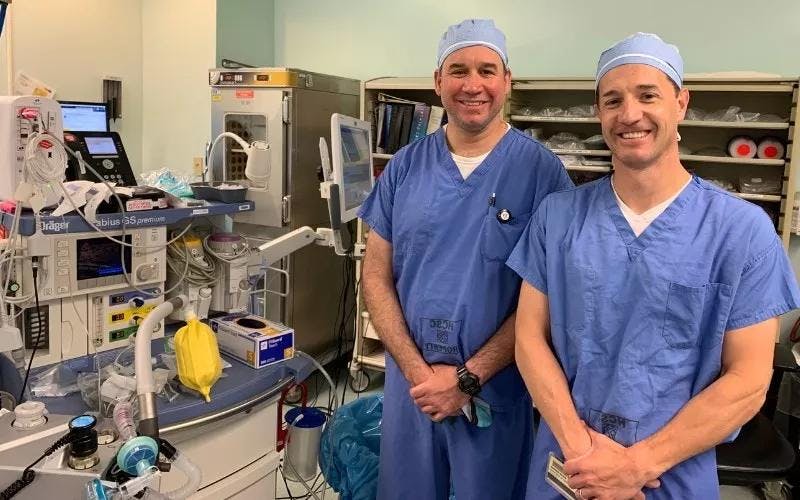You breathe in, you breathe out. It's the way the body works. It's the same with the anesthesia gases you receive during surgery. You breathe in gases like desflurane, which helps people go to sleep quickly and wake up quickly. And then you breathe out the unused gases into the environment.
Unused anesthesia gases exhaled by patients are potent greenhouse gases, contributing to global warming and accounting for 5% or more of a hospital's carbon footprint. This is why WellSpan is seeking ways to reduce its use of certain anesthetic gases while also safely caring for and ensuring the comfort of patients.
"The real concern is that the anesthetic gases sit in the atmosphere just like carbon dioxide does," says Dr. Andrew Shorb, a WellSpan ear, nose, and throat physician who regularly performs surgery in the operating room. "Most people think of carbon dioxide as the biggest greenhouse gas. Desflurane is described as having a 2,500 times greater global warming potential than carbon dioxide."
Dr. Shorb is part of WellSpan's Physician Leadership Academy, which seeks to develop the next generation of physician leadership at WellSpan. A Leadership Academy team is working with others on WellSpan's surgical administration, supply chain, environmental services, and sustainability teams on the anesthetic gas reduction project.
WellSpan has made a commitment to reduce its greenhouse gas emissions by 50% by 2030. The health care industry is a major contributor to rising greenhouse gas emissions, emitting 8.5% of all U.S. greenhouse gas emissions and spending about $8.3 billion in energy annually to support its operations.
"Reducing our greenhouse gas emissions is one of WellSpan's sustainability goals," says Keith Noll, WellSpan senior vice president and chief administrative officer, who is working with the Leadership Academy team on its efforts. "As a system, we have embarked on a variety of sweeping changes to become more sustainable by recycling, reprocessing, sustainable purchasing, and conserving energy. We know we have a responsibility to care for our neighbors in South Central Pennsylvania and also for our planet."
WellSpan hopes to reduce the anesthesia footprint through several initiatives:
- Educating and informing anesthesia leaders. The team sent a letter to providers with information about gases, their environmental impact, and costs. The letter also had data on baseline usages at WellSpan.
- Promoting the use of more intravenous anesthetics.
- Promoting the use of more local anesthetics or regional anesthetics, like spinal blocks.
- Examining the current anesthesia gas system to ensure that valves are working and that there are not a lot of leakages in the tanks or system emitting gases into the air.
Dr. Shorb said WellSpan is taking a cooperative approach.
"We are not telling providers that they need to get rid of a certain gases but asking them to consider when they use it and why and hoping we can be on the leading edge of phasing out some of these gases," Dr. Shorb says.
At the top of the list is desflurane, an anesthetic gas that lasts in the atmosphere for 14 years. Eight hours of using desflurane is comparable to driving a car 1,600 miles, in terms of its atmospheric impact.
Hospitals in Europe have banned or are in the process of banning the use of this gas because of its environmental effects. Fortunately, Dr. Shorb says, there are good alternatives, such as sevoflurane, which has a much lower impact on the environment.
Dr. Greg Katos, an anesthesiologist at WellSpan Ephrata Community Hospital, says that these environmental concerns are being discussed and implemented by anesthesiologists across the country.
"In our current practice, we have already taken steps to limit the routine use of desflurane. We more frequently use sevoflurane, which has an inherently lower carbon footprint," Dr. Katos said. "We also continually update our best practices as new data and information become available, including recent guidance that suggests these medications can be safely used in a manner that further reduces environmental impact."
WellSpan will track usage of certain gases and see if numbers are trending down, Dr. Shorb says. Providers have been positive about making the changes, he notes, while also remaining focused on offering the right type of anesthesia to comfortably care for patients who are undergoing surgery or procedures.
"I think we all have concerns for environmental changes," he says. "We see the weather pattern changes and we see things that are happening globally. The more you look at projects like this that are targeting sustainability and environmental impact, the more you realize we need to act now."
To learn more about WellSpan's sustainability efforts, go here.
Tags:

